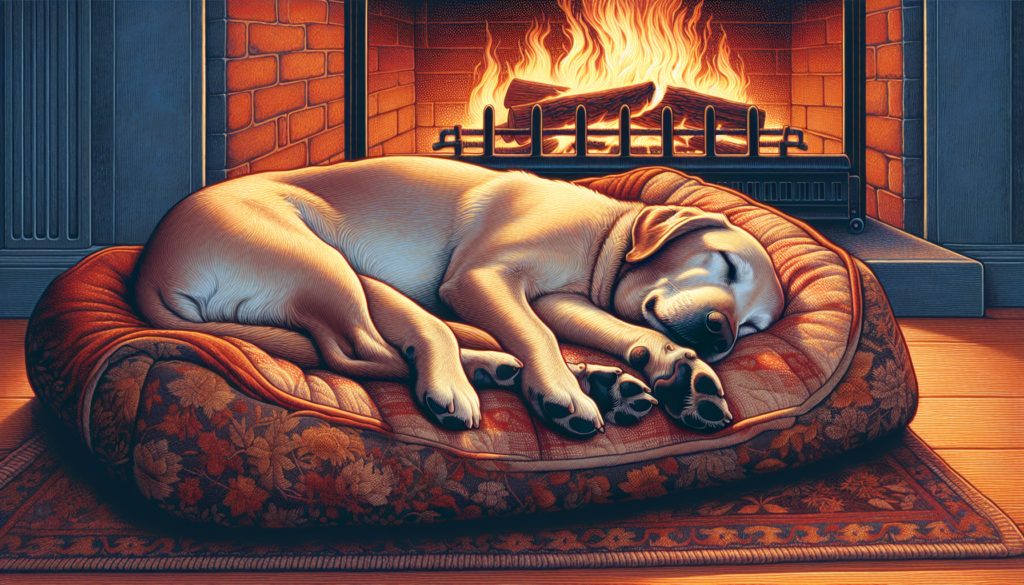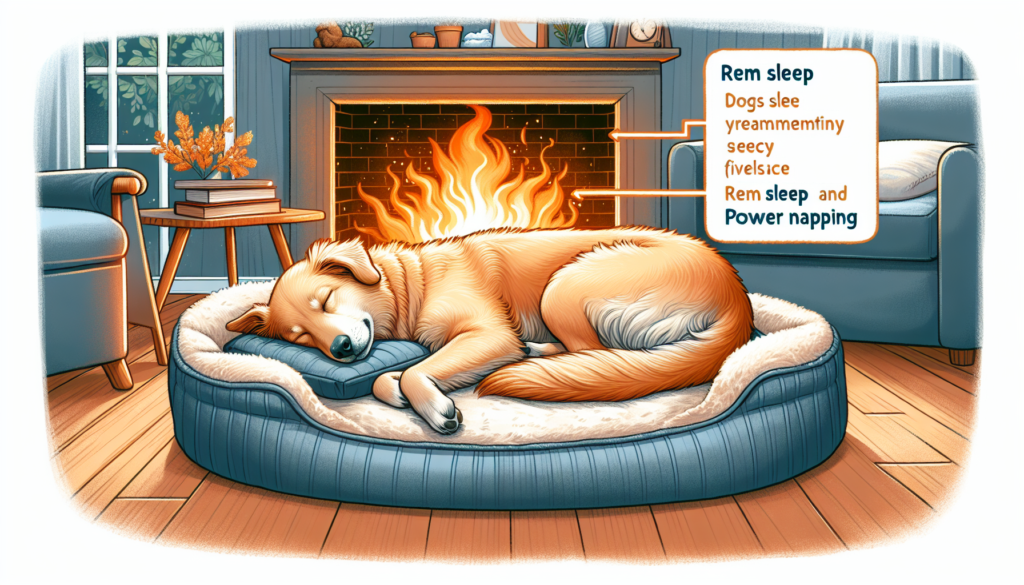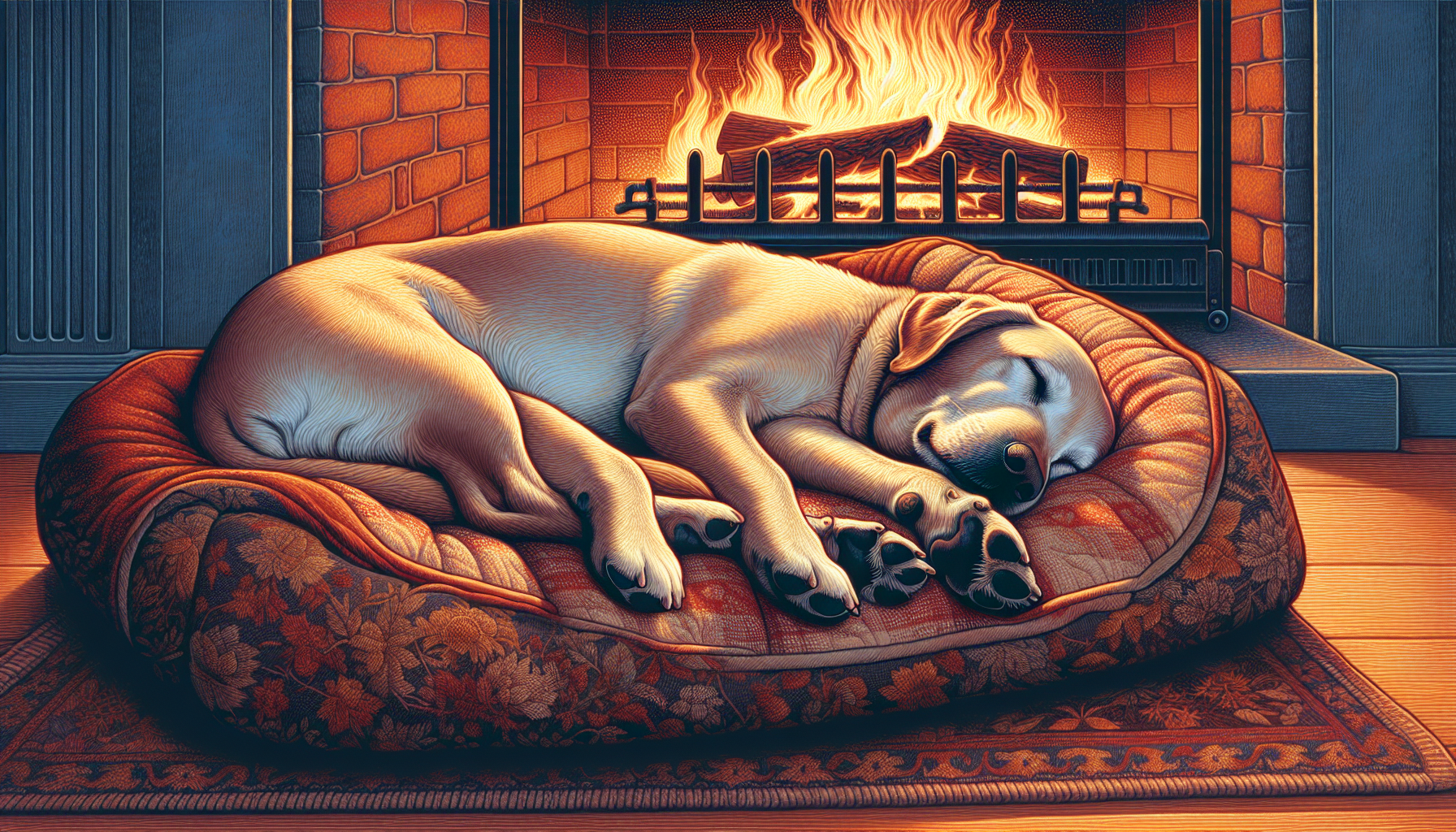Do you ever wonder why your furry friend seems to spend most of their time snoozing? In this article, we will explore the fascinating world of dog sleep patterns. As dog owners, it’s important to comprehend and appreciate the different stages of sleep our beloved canines experience. From rapid eye movement (REM) sleep to deep sleep, we will uncover the reasons behind their quirky sleeping positions, dream-filled movements, and occasional howling during slumber. So, prepare to learn more about your four-legged companion’s snooze habits and discover the secrets behind doggy dreams!

Sleep Duration
Puppies vs Adult Dogs
When it comes to sleep duration, puppies and adult dogs have different needs. Puppies, being in their developmental stage, require more sleep compared to adult dogs. On average, puppies need around 18 to 20 hours of sleep per day. This is because their growing bodies and brains need a lot of rest in order to properly develop. As puppies age, their sleep patterns gradually change, and by the time they reach adulthood, they typically require around 12 to 14 hours of sleep per day.
Large vs Small Breeds
The size of a dog also plays a role in their sleep duration. Generally, larger breeds tend to sleep more than smaller breeds. This is because larger dogs have more body mass and may require additional rest to recover from physical exertion. On the other hand, smaller breeds have higher metabolism rates, which can lead to them being more active during waking hours and requiring slightly less sleep. However, it’s important to note that individual differences and factors such as age, health, and activity level can also affect the sleep duration of dogs of all sizes.
Different Dog Breeds
While puppies and size may affect sleep duration, different dog breeds may also have variations in their sleep patterns. Some breeds are known to be more active and require less sleep, while others may be more inclined to sleep for longer periods of time. For example, working breeds such as Border Collies and Cattle Dogs tend to have higher energy levels and may sleep less compared to breeds like Bulldogs or Basset Hounds, which are known for their more laid-back and relaxed nature. It’s essential to take into consideration the individual characteristics of each breed when considering their sleep habits.
Sleep Stages
Non-REM Sleep
Dogs, like humans, go through different stages of sleep. The first stage is non-REM sleep, which consists of two sub-stages. The first sub-stage is a light sleep phase where the dog may easily wake up if disturbed. The second sub-stage is a deeper sleep phase where the dog is less responsive to stimuli. During non-REM sleep, the body repairs itself, and growth and development occur. It is common for dogs to spend a considerable amount of time in non-REM sleep, especially during the first half of their sleep cycle.
REM Sleep
The next stage of sleep is REM (Rapid Eye Movement) sleep. This is the stage where dreaming occurs. During REM sleep, the brain is highly active, and the dog’s eyes may move rapidly beneath the closed eyelids. It is during this stage that the dog’s brain processes information and consolidates memories. REM sleep is essential for dogs’ mental and emotional well-being. While humans spend a more significant portion of their sleep in REM, dogs tend to have shorter REM periods, making up about 10-15% of their total sleep time.
Sleep Position
Curling Up
One common sleep position seen in dogs is curling up. This position is especially prevalent in smaller breeds or those that feel more secure in a confined space. By curling up, dogs can conserve body heat and protect their vital organs. It also allows them to feel safe and cozy as they sleep. Curling up assists in regulating body temperature, as dogs lose heat through their paws, ears, and noses.
On the Side
Another common sleep position is sleeping on the side. This position is often observed in larger breeds or dogs that feel comfortable and relaxed in their environment. Sleeping on the side indicates that the dog is at ease and feels secure enough to expose its belly, a vulnerable area. Dogs who sleep on their sides are typically comfortable and content in their surroundings.
On the Back
Sleeping on the back, also known as the “plank” position, is less common but may be occasionally seen in dogs. This position is a display of trust and vulnerability, as it exposes the dog’s belly and vital organs. Dogs who sleep on their backs may feel exceptionally secure and protected in their environment. While this position is not as common, it can be quite adorable to witness.
Sprawled Out
Some dogs have the tendency to sprawl out while they sleep. They lay on their bellies with their legs stretched out in different directions. This position allows dogs to cool down, especially in warmer weather. It helps them regulate their body temperature, allowing heat to dissipate more effectively. Dogs who prefer this sleep position may be more carefree and unpretentious in their nature.
Sleep vs Rest
It’s important to note that although dogs spend a significant portion of their time sleeping, it doesn’t mean they are always in a deep sleep. Resting and sleeping are two different things for dogs. While sleeping involves going through different sleep stages, resting refers to a state of relaxation where the dog is awake but not actively engaged in any activity. Resting helps dogs recharge their energy and prepares them for their next active period.

Sleeping Habits
Sleep-Wake Cycle
Dogs have a natural sleep-wake cycle, which is influenced by their internal body clock, also known as the circadian rhythm. This cycle typically follows a pattern of being awake during the day and resting or sleeping during the night. However, it’s essential to remember that dogs are adaptable and can develop routines based on their environment and the habits of their human family members. Maintaining a consistent sleep-wake cycle can promote healthy rest and improve overall well-being.
Napping
In addition to their main sleep periods during the night, dogs may also take naps throughout the day. Napping allows dogs to rest and recharge, especially after periods of activity or play. The frequency and duration of naps can vary depending on factors such as age, breed, and activity level. Puppies and older dogs may require more frequent naps to cope with their higher energy or to recover from physical exertion.
Dreaming
Just like humans, dogs experience dreams during their REM sleep stage. You may have observed your dog twitching, whimpering, or even barking while asleep. These movements are often indications that they are immersed in a dream. It’s fascinating to imagine what dogs might be dreaming about, whether it’s chasing squirrels, playing fetch, or simply enjoying a delightful day at the park. Dreams play a crucial role in dogs’ mental and emotional well-being, and they are a natural part of their sleep patterns.
Factors Affecting Sleep
Age
Age plays a significant role in a dog’s sleep patterns. Puppies require more sleep as they are going through crucial developmental stages. As they grow and mature, their sleep needs gradually decrease. Older dogs, on the other hand, may experience changes in their sleep patterns due to age-related factors, such as cognitive decline or health issues. It’s important to provide puppies with a cozy and secure place to sleep, while older dogs may benefit from additional comfort measures.
Physical Activity
The level of physical activity a dog engages in throughout the day can impact their sleep patterns. Dogs that have had ample exercise and mental stimulation are more likely to sleep better at night. Regular walks, playtime, and interactive games help dogs release pent-up energy, leading to a more restful sleep. However, it’s important to find the right balance, as excessive activity close to bedtime may leave dogs too stimulated to relax and settle down for sleep.
Health Conditions
Certain health conditions can affect a dog’s sleep. Pain, discomfort, or underlying medical issues can disrupt their sleep patterns. Dogs suffering from conditions such as arthritis or gastrointestinal problems may experience difficulties finding a comfortable sleeping position or may wake up during the night due to discomfort. It’s crucial to monitor any changes in your dog’s sleep patterns and consult with a veterinarian if you suspect a health issue.
Environmental Factors
The environment in which a dog sleeps can also influence their sleep patterns. Factors such as noise, temperature, lighting, and the presence of other pets or people can impact their ability to rest peacefully. Dogs are sensitive to their surroundings, and providing them with a quiet, comfortable, and secure sleep environment can promote better sleep quality. Consider providing a cozy bed or crate in a quiet corner of the house to create a sleep-friendly space for your dog.
Common Sleep Problems
Insomnia
Insomnia, characterized by difficulty falling asleep or staying asleep, can also occur in dogs. Dogs with insomnia may exhibit restlessness, pacing, or whining during the night. Underlying medical conditions, anxiety, or environmental factors can contribute to insomnia in dogs. If your dog consistently struggles with sleep, it’s important to consult with a veterinarian to rule out any underlying health issues and address the problem effectively.
Sleep Apnea
While less common in dogs compared to humans, sleep apnea can occur in certain breeds. Sleep apnea is characterized by brief pauses in breathing during sleep, which can disrupt the quality of sleep and lead to daytime sleepiness or fatigue. Breeds with brachycephalic (short-faced) features, such as Bulldogs or Pugs, have a higher risk of experiencing sleep apnea. If you suspect your dog may be experiencing sleep apnea, it is crucial to seek veterinary assistance.
Restless Leg Syndrome
Restless Leg Syndrome (RLS) is a condition characterized by an uncontrollable urge to move the legs, typically accompanied by discomfort. While RLS is mostly observed in humans, some dogs may also exhibit similar symptoms. Dogs with RLS may show repetitive leg movements or jerking during their sleep, causing disturbances in their sleep patterns. If you suspect your dog may be experiencing RLS, it is recommended to consult with a veterinarian for proper diagnosis and management.
Nightmares or Sleep Terrors
Dogs, just like humans, can experience nightmares and sleep terrors. These are characterized by intense, often frightening, dreams that can result in physical reactions such as whimpering, barking, or involuntary movements. Nightmares and sleep terrors in dogs can be caused by various factors, including anxiety, past traumas, or even certain medications. Providing a safe and secure sleep environment, addressing underlying anxieties, and consulting with a veterinarian can help manage these sleep disturbances.
How to Help Your Dog Sleep Better
Creating a Comfortable Environment
Creating a comfortable sleep environment is essential for your dog to sleep better. Invest in a suitable bed or crate that offers adequate support and cushioning. Consider the location of the bed, taking into account factors such as noise, temperature, and the presence of other pets or people. Providing a calm and quiet space free from distractions can significantly improve your dog’s sleep quality.
Establishing a Bedtime Routine
Establishing a consistent bedtime routine can help signal to your dog that it’s time to sleep. Incorporate activities that promote relaxation, such as a short walk, gentle playtime, or gentle brushing. Avoid stimulating activities or excessive food or water intake close to bedtime. Following a regular routine can help your dog unwind and prepare for a restful night’s sleep.
Addressing Health Issues
If you notice any changes in your dog’s sleep patterns or suspect underlying health issues, it’s crucial to address them promptly. Schedule regular vet check-ups to monitor your dog’s overall health and well-being. If necessary, consult with a veterinarian about any specific sleep problems or disturbances your dog may be experiencing. By addressing and managing any underlying health issues, you can help your dog achieve better sleep quality.
Sleeping with Your Dog
Benefits
Sleeping with your dog can bring various benefits to both you and your furry companion. For many dog owners, having their dog in their bed can create a sense of comfort, companionship, and security. Dogs are known for their ability to provide emotional support, and having them close during sleep can promote a deeper bond between you and your pet. Furthermore, the warmth and rhythm of a sleeping dog’s breathing can be soothing and comforting, promoting a sense of relaxation and better sleep for some individuals.
Considerations
While sleeping with your dog can be a positive experience, it’s important to consider certain factors. Some people may have allergies or asthma that can be triggered by pet dander or fur, making it necessary to establish boundaries and keep the dog off the bed. Additionally, some dogs may exhibit restless or disruptive sleep behaviors, such as excessive movement or snoring, which can disturb your sleep. It’s essential to assess whether sharing a bed with your dog is suitable for both you and your furry friend, taking into account individual preferences and considerations for a peaceful night’s sleep.
Conclusion
Understanding your dog’s sleep patterns is key to ensuring their overall health and well-being. Factors such as age, breed, and individual characteristics can influence the duration and quality of their sleep. By creating a comfortable sleep environment, addressing health issues, and establishing a consistent sleep routine, you can help your dog achieve better sleep. Remember, a well-rested dog is a happier and healthier companion, ready to embark on new adventures with you.

